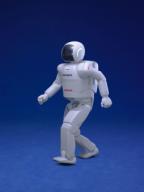ASIMO Demonstrates Advances in Robotics
 |
TOKYO - April 7, 2008: Hajime Horiguchi writing for the Asahi Shimbun reported that; if you are a hotel butler or a waiter you'd better watch your back. There's a robot out there that's after your job. Maybe not today or even next year, but the handwriting, scribbled by a robotic arm with flexy fingers, is on the wall.
In December, Honda Motor Co. announced the birth of their latest ASIMO robot. And this one goes where no other hunk of wires, composite materials and IC chips has gone before.
According to its builder, the latest ASIMO can greet and escort guests. After getting its assigned humans sorted out, it can bring them a tray of drinks.
The humanoid biped is "comfortable" around its creators, meaning it chooses its movements independently. This allows it to dodge bumbling humans--a critical skill in a crowded country like Japan.
Additionally, ASIMOs can communicate with each other to complete shared tasks.
Honda began developing ASIMO in 1986. Twenty-two years later, the robot is much closer toward becoming a machine that thinks and acts on its own.
Engineers put the latest ASIMO incarnation through its paces at Honda's Aoyama headquarters in Tokyo last December.
Just like ramen shop employees everywhere, a group of identical ASIMO robots welcomed visitors with the ubiquitous greeting of "Irasshaimase" (welcome). Honda programmed the robots to respond to IC cards attached to the guests.
The robots were then tasked with ushering the guests to a table. They were also programmed not to trample the fragile humans. Safely seated, the guests ordered drinks by accessing a terminal on the table. An ASIMO "waiter," equally adept at pushing a drink trolley or carrying a tray, delivered the beverages.
The latest ASIMO has what Honda engineers call "advanced autonomy."
The bipedal robot can weave its way through a lobby teeming with humans. It chooses its options: Smoothly moving past oncoming humans, or if a collision appears imminent, stepping back and yielding the right-of-way.
To avoid squashing a toddler, ASIMO receives and analyzes data streaming to its processor from its eye camera. It identifies the direction and speed nearby humans are moving; does a lot of cool calculations, predicts forthcoming movements and then decides on an appropriate action. For example, it might spot a fast-moving dachshund and decide to take evasive action.
December's event was the first time Honda has allowed the public to see ASIMO robots strut their stuff in a space crowded with humans. Previously, the engineers only displayed ASIMO in a controlled environment, usually on a stage.
Another new ASIMO ability is task sharing. While one ASIMO might tote the teapot, another could hand out the cups to guests.
ASIMO robots talk to each other just as other computers do, via a Wi-Fi network. This communication allows the robots to determine where each ASIMO is, its status (delivering a daiquiri or dodging that pesky dachshund) and how to execute shared tasks most efficiently.
The man in charge of ASIMO development is Masato Hirose, 52, senior chief engineer and general manager of Research Division 2, Honda R&D Co. Wako Research Center.
Asked about his project, he replies with obvious pride, "Our robot now shares the same floor space with humans."
In July 1986, a group of engineers at Honda R&D led by Hirose began work on a secret project. Hirose had just joined Honda after a stint at a machine tools manufacturer. The group's battle cry--which probably sounds better in Japanese--was: "Let's build our own Astro Boy!"
In addition to the obvious technical hurdles, the company was worried about how people would react to robots shaped like humans.
Honda officials even visited the Vatican, the center of Roman Catholic faith, for help with their ethical quandary. A company spokesperson recalls that they were told: "God trusts humankind. There is no problem."
After 10 years, Honda unveiled its P2 robot in December 1996. It was the world's first self-contained, bipedal humanoid robot.
The P2 was 182 centimeters tall. Packed with a processor and Wi-Fi devices, it weighed in at 210 kilograms or about the size of an NFL linebacker. Too big, too scary.
Four years later, Honda engineers succeeded in shrinking their project. The latest model is a svelte 130 centimeters tall and weighs 54 kilograms.
According to the Japan Robot Association, Japan leads the world in robot technology. The country produces two thirds of the world's industrial robots.
Honda does not have the humanoid robot niche to itself, even in Japan. Also in December, its rival, Toyota Motor Corp., unveiled a new "partner robot" for housework and nursing care.
Honda's stated goal is to provide one robot per household, freeing humans from humdrum chores. But you're going to have to wait--ASIMO won't be delivering beer and little wieners on toothpicks anytime soon.
Just to lease one costs 20 million yen a year. And they are not for sale. Honda's Hirose says he hopes to bring a commercial version of ASIMO to market around 2015.
* * *
Evolution of a bipedal robot
1986: Development begins. Early prototype is a legs-only model.
1988: Smooth walking at 1.2 km/h attained.
1993: First humanoid model, P1, completed. P1 able to manipulate objects.
1996: P2, the world's first humanoid biped robot, is completed. P2 can climb stairs and push carts.
2000: First ASIMO is completed. ASIMO is trimmed down to 120 centimeters, to make it less intimidating without compromising performance.
2002: ASIMO is refined. It can greet people and recognize up to 10 faces.
2005: New ASIMO runs at 6 km/h and can walk while holding hands with people.
2007: Latest model able to make autonomous decisions.


